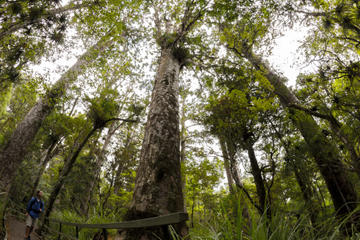Puketi Rainforest
TIME : 2016/2/22 12:09:51

Puketi Rainforest
For as much attention as the Bay of Islands receives for its empty beaches and coves, one of the best sights near the Bay of Islands has nothing to do with the water. Rather, the Puketi rainforest is set inland from the coast in some of the best-preserved wilderness in the Northland.
Set only a short drive from the Bay of Islands, this lush expanse of native foliage stretches over 37,000 acres of terrain. Here, kauri trees over 120 feet in height keep a watchful eye over the forest, and parts of the land have remained completely untouched since the arrival of the island’s first humans. In addition to the kauri—native hardwoods which were prized by Maori and exploited by European shipbuilders—there are over 370 different species of plants which thrive in the Puketi rainforest. Given the unique climate of the Northland and its geographical obscurity, a few of these plants are endemic to New Zealand and exist nowhere else in the world.
More so than simply the trees and the forest, many travelers visit the Puketi rainforest for the numerous species of birds. This is one of the few places left on the North Island with a wild population of Kiwi, and other birds such as the New Zealand Pigeon (
kukupa) have been known to be sighted in the forest. Thanks to the efforts of local conservation groups, other species such as the New Zealand robin (
toutouwai) have been re-introduced to the forest, and environmental efforts are currently focused on creating a sustainable habitat for their survival.
While the Puketi rainforest is open to the public, the best way to experience the forest is with some sort of a guided tour. The tours are able to provide transport from the Bay of Islands, and the knowledgeable guides who lead walks through the forest can point out features which might otherwise go unseen. For the best chance of finding birds and wildlife, consider visiting the forest at night for a tour beneath the glow of a headlamp. Here, in the silence of the forest and the creak of the kauri above you, you can truly get the feeling for the beauty of the Northland as it’s existed since the island first formed.
